Electric Charge: Definition, Types, Properties, Equations, Charge Formulas and Example Problems
Hello guys, do you know that electric charge? On this occasion About the knowledge.co.id will discuss what it is Electrical charge and other elements about it. Let's look at the discussion together in the article below to better understand it.
Electric Charge: Definition, Types, Properties, Equations, Charge Formulas and Example Problems
For you students, of course you have often heard about electric charge, even at home, whether you realize it or not You often see the existence of an electric charge in something that can attract or repel one another other. For example, surely you have seen that there is a plastic attraction that attracts glass, or maybe you have practice yourself if the plastic is rubbed into the hair of the dry head so that the plastic can attract pieces of paper nearby.
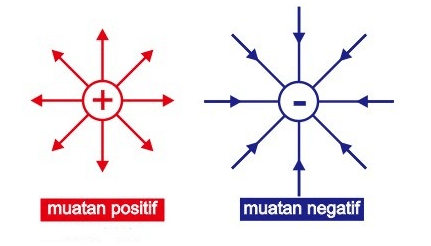
Things like that can happen because there is an electric charge in it, and not only the examples above, of course there are many more an example of an electric charge between objects that attract or repel each other in our daily lives day. Therefore it is very good for you high school (high school) students to better understand and master what is electric charge because you cannot It is undeniable that the Electric Charge Module in Physics Subject appears quite often in the High School Physics Subject Test Questions, both School Test Questions and Test Questions National.
Definition of Electric Charge
Electric charge is the nature or basic charge carried by elementary particles, causing these elementary particles to experience attractive and repulsive forces. The electric charge of an elementary particle can be either positive or negative. If 2 objects have the same charge, they will repel and the two goods will attract if they have different types of charge. It should be noted, elementary and subatomic particles such as electrons and protons have an electric charge. Electrons are negatively charged and protons are positively charged.
Electric charge is the basic charge that something has, which makes it experience a force on other objects that are next to each other and also have an electric charge. The symbol Q is often used to describe charge. The International System of Units (Sang) of the unit Q is the coulomb, which is 6. 24 x 1018 base charge.
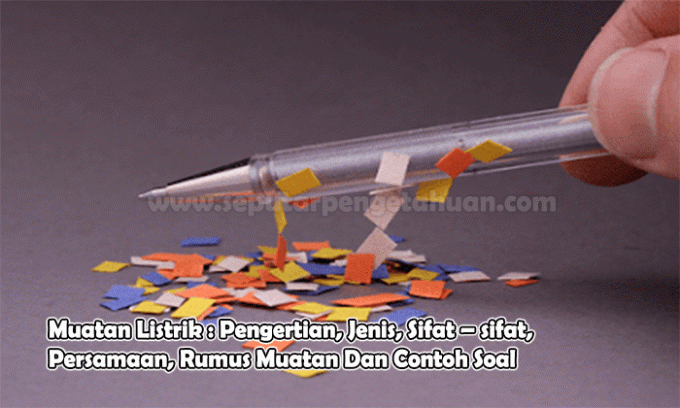
Type of Electrical Charge
There are also types of electric charge, among others, namely:
Positive Electric Charge (Proton)
According to Benjamin Franklin, Positive Electric Charges are usually mutually repelling with something that is charged, and in this case it happens because the positive charges are of the same kind so they will act against each other reject.
Negative Electric Charge (Electrons)
According to Benjamin Franklin, Negative electric charge on an item can be determined if there is an item that has a negative charge as well repel each other with plastic that has a charge, so that it can be determined if the cargo is negative.
A more complete description is:
- Charge of 1 electron=- 1, 6. 10- 19 coulombs
- Charge of 1 proton=+1.6. 10- 19 coulombs
The electric charge of an item is determined by the number of protons and electrons it contains.
- If an item has excess electrons = lack of protons (Σ electrons
Σ Proton), until the object is negatively charged - If an item lacks electrons = excess protons (Σ electrons < Σ Protons), so that the item is positively charged
- If the number of electrons = the number of protons (Σ protons = Σ electrons) until the object is not charged (neutral charge)
Properties of Electric Charge
Objects that are electrically charged, when brought closer to each other, can experience an attractive or repulsive force.
Attraction occurs when the object that is brought closer has a different electric charge (positive and negative charge).
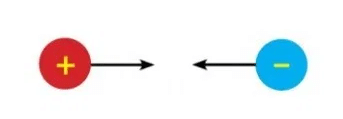
The repulsive force occurs when the object that is brought closer has the same or the same electric charge (positive charge with positive or negative charge with negative).
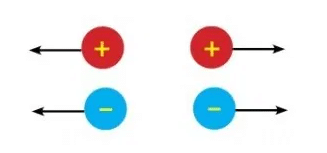
Thus, the properties of electrically charged goods can be summed up as follows:
- Objects that have the same electric charge will repel each other.
- Objects that have different electrical charges will attract each other.
Electric Charge Equation
Q = n.e
Where :
Q= Electric charge (Coulomb)
n= The number of electrons
e = Electro charge – 1.6 x 10- 19C
Electrostatic phenomena are all around us, electric charge has a positive charge and a negative charge. Positive charge is carried by protons, and negative charge is carried by electrons. Unit of charge "coulomb (C)", proton charge +1.6 x 10-19C, otherwise electron charge -1.6x 10-19C. Electric charges with the same sign repel each other, electric charges with different signs attract each other.
Electric Charge Formula
The formula that applies to electric charge is a mathematical formula from Coulomb's law. Coulomb's law was discovered by Charles Augustin de Coulomb in the late 18th century. This French scientist in the field of physics created a law called Coulomb's law. This law reads
"The force of attraction or repulsion between 2 electric charges is proportional to the charges and inversely proportional to the square of the distance separating the two charges."
mathematically:
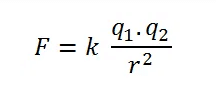
with
F = attractive / repulsive force (newtons)
q = electric charge (coulombs)
r = distance between the two charges
k= constant = 1/ 4πεo = 9 x 109 N.m2/ C2
εo = electrical permittivity in vacuum / air = 8.85 x 10 – 12 C2/Nm2
If the charge medium is not in a vacuum or air medium then the magnitude of the force between the charges q1 and q2 will be smaller
F air / vacuum < F medium
This is because the value of the electrical permissiveness in the non-air medium is greater. The permittivity εo is exchanged for ε ie
ε=εrεo
in vacuum the value of εr is 1, whereas in air εr is 1.0006. Thus the coulomb force in the medium is the formula

Problems example
There is an object with a mass of 40 g and a charge of q1 = 1µC hanging from a light string of negligible mass. Right to the left of the item is placed a charge q2 with a charge of – 2μC which causes the position of the item to shift to the left (see picture below). If it is known that k = 9.109 Nm2 / C2 and Gram = 10ms-2, determine how much tension the rope feels!
Answer :
To answer this question, you must first determine the magnitude of the coulomb force (charge attraction) and then to find the tension we use the Pythagorean rule because the tension in the rope is the resultant of 2 forces, the weight of the charge q1 and the force coulombs.
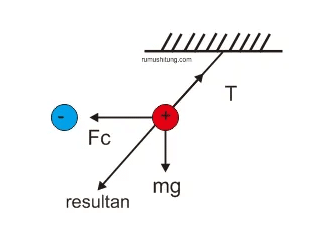
so that

answer to the electric charge question:
After the attractive force of attraction between the two electric charges has met, to find the tension in the rope we look for the resultant with the weight of the charge
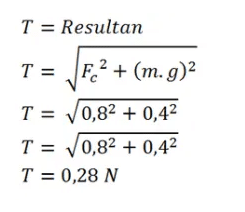
So the magnitude of the rope tension that occurs is 0.28 N.
Thus the review from About the knowledge.co.id about Electrical charge, hopefully can add to your insight and knowledge. Thank you for visiting and don't forget to read other articles.
List of contents
Recommendation:
- √ Definition of One Variable Linear Equation (PLSV) & Examples… Definition of One Variable Linear Equation (PLSV) & Example Problems - In this discussion we will explain about one variable linear equation. Which includes the understanding of the notion of a linear equation one variable and...
- Example of Cultural Arts Questions for Class 10 (X) SMA/MA/SMK Semester 1… Examples of Class 10 (X) Cultural Arts Questions for SMA/MA/SMK Semesters 1 and 2 (2019 and 2020) - On this occasion, Seputarknowledge.co.id will discuss Multiple Choice Class 10 Cultural Arts Questions and Essay…
- Striated Muscles: Definition, Characteristics, Properties, Functions, How it Works and… Striated Muscle: Definition, Characteristics, Properties, Functions, How it Works and Its Parts - What is meant by Striated Muscle and its Functions? On this occasion, Seputarknowledge.co.id will discuss about Striated Muscles and…
- Epigram Poetry: Definition, Characteristics and Examples Epigram Poetry: Definition, Characteristics and Examples - What is meant by epigram poetry and for example?, On this occasion Seputarknowledge.co.id will discuss it and of course about it others that…
- Professional Ethics: Definition, Benefits, Purpose, Principles, and… Professional Ethics: Definition, Benefits, Purpose, Principles, and Examples - What is Professional Ethics? On this occasion we will discuss what is meant by Professional Ethics and several things...
- Graphic Arts: Definition, History, Types, Characteristics, Comparison… Graphic Arts: Definition, History, Types, Characteristics, Comparisons and Examples of Graphic Arts - Hello guys, do you know Graphic Arts? On this occasion, Seputarknowledge.co.id will discuss what art is…
- Quadratic Equations: Definition, Types, Properties, Formulas and… Quadratic Equations: Definition, Types, Properties, Formulas and Example Problems - What are quadratic equations and formulas the root? On this occasion, Seputarknowledge.co.id will discuss what is a quadratic equation, the root formula And…
- √ Definition of Living in Harmony, Benefits, Values, Forms and… Understanding Living in Harmony, Benefits, Values, Forms and Examples - On this occasion, Around Knowledge will discuss Living in Harmony. Which in this discussion explains the meaning of living in harmony, benefits,…
- Motivational short stories: definition, writing tips and examples Motivational Short Stories: Definition, Writing Tips and Examples - What is a Motivational Short Story?, On On this occasion, Seputarknowledge.co.id will discuss whether it is the Short Story of Friendship and other matters about it. Let's see…
- The Watt Formula: Definition, Units, Symbols and Relationships… The Watt Formula: Definition, Unit, Symbol and Relationship with Amperes and Volts - What is the watt formula and how to implement it? things…
- Attributes of Allah: Necessary Attributes, Impossible Attributes, Jaiz Attributes and… Attributes of Allah: Necessary Attributes, Impossible Attributes, Jaiz Attributes and Their Explanations - What are the Attributes of Allah that we need to understand. On this occasion, Seputarknowledge.co.id will discuss the characteristics of...
- Ligaments Are: Definition, Anatomy, Structure, Functions,… What is a Ligament: Definition, Anatomy, Structure, Function, Types, Mechanism of Action - What is a Ligament? Ligaments are part of the fibrous connective tissue that allows joints and bones to join. To know more about it, let's…
- Properties of Gambyong Dance: Definition, History and Functions… Properties of the Gambyong Dance: Definition, History and Functions of the Gambyong Dance - What do you know about the gambyong dance?, On this occasion, Se regarding the knowledge.co.id will discuss it and of course things…
- Sample Physical Education Questions for Class 11 (XI) SMA/MA/SMK Semester 1 and 2 Examples of Physical Education Questions for Class 11 (XI) for SMA/MA/SMK Semester 1 and 2 (2019 and 2020) - On this occasion, Seputarknowledge.co.id will discuss examples of Physical Education Questions for Class 11 Multiple Choice and Essay...
- Definition of Chemical Elements and Their Grouping (Discussion… Definition of Chemical Elements and Their Grouping (Full Discussion) - Here will be discussed about understanding of chemical elements, grouping or division of chemical elements based on their nature and based on his discovery. Let's look at the discussion below...
- Indefinite Integral: Definition, Formulas, Properties and Examples… Indefinite Integral: Definition, Formulas, Properties and Examples of Problems - What is meant by Indefinite Integral Of course and how to calculate the mathematical operations? will…
- Ijarah Law: Definition, Legal Basis, Requirements, Pillars, Types of… Ijarah Law: Definition, Legal Basis, Terms, Pillars, Types and Terms - What is Ijarah law and basically?, On this occasion Seputarknowledge.co.id will discuss it and of course about it other…
- Short Story Text: Definition, Characteristics, Structure, Elements and Examples Short Story Text: Definition, Characteristics, Structure, Elements and Examples - What is a Short Story Text? Let us…
- Cone formulas, characteristics, properties, elements and examples of problems Cone Formulas, Characteristics, Properties, Elements and Examples Problem - How to calculate the area and volume of a shape cone space?, On this occasion, Seputarknowledge.co.id will discuss it and of course about other things Which…
- Intersections Are: Forms, Connections, Impacts, Characteristics, Examples… Intersections are: forms, connections, impacts, characteristics, examples and their relationship to consolidation - what is in what do you mean by intersection? On this occasion, Seputardinding.co.id will discuss it and of course other formulas…
- Understanding Magnets, Types and Properties of Magnets (Discussion… Understanding Magnets, Types and Properties of Magnets (Full Discussion) - On this occasion we will discuss the meaning of magnets, types of magnets and also the properties of magnets. The word magnet itself is of course...
- Prayer and Dhikr After Prayer Prayer and Dhikr After Prayer - How are the readings of Prayer and Dhikr after prayer? Let's look at the discussion together...
- Renaissance Age Renaissance Period: Definition, History, Background and Characters - What is meant by the Renaissance era? On this occasion, Seputarknowledge.co.id will discuss it and of course about other things that also…
- 6 Ways to Memorize Quickly, Effectively and Easily aroundknowledge.co.id - Learning how to memorize quickly and easily isn't too difficult if you use the right strategy. However, most people do not use the right strategy. In fact, most people don't use the strategy…
- Ionic Bonds: Definition, Characteristics, Properties and Examples of Compounds Ionic Bonds: Definition, Characteristics, Properties, and Examples of Their Compounds - On this occasion, Around the Knowledge.co.id will discuss about ionic bonds and of course about other things that also cover it. Let's see together…
- Vector: Definition, Material, Formulas and Example Problems Vector: Definition, Material, Formulas and Example Problems - What is meant by Vector in operation mathematics? On this occasion, Around the Knowledge.co.id will discuss vectors and other matters about it.…
- Derived Algebraic Functions: Formulas, Applications, Notation, Multiplication… Derivative of Algebraic Functions: Formulas, Applications, Notation, Multiplication of Division by Two Functions and Example Problems - Do you understand what is meant by Derivative of an Algebraic Function? On occasion…
- News Text: Definition, Characteristics, Elements, Structure, Terms,… News Text: Definition, Characteristics, Elements, Structure, Terms, Language Rules, Writing Guidelines and Examples - What is meant by News Text? On this occasion, Seputarknowledge.co.id will discuss about...
- Vertical Downward Motion: Definition, Characteristics, Physical Quantities,… Vertical Downward Motion: Definition, Characteristics, Physical Quantities, Formulas and Example Problems - On this occasion Around the knowledge.co.id will discuss Vertical Downward Motion, formulas and of course other things Also…
- Three Variable Linear Equation System: Features, Components,… System of Three Variable Linear Equations: Features, Components, Solving Methods and Example Problems - What is in what do you mean by a system of three-variable equations? On this occasion, Seputarknowledge.co.id will discuss it...
